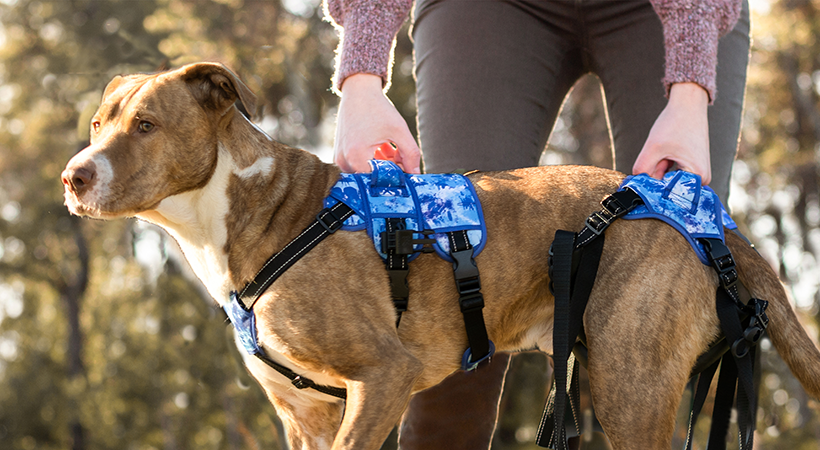- May 17, 2023
How to Safely Lift and Carry Your Dog

You might need to carry, lift, or pick up your dog for countless reasons. Whether it’s to help your dog get into the car, lift them onto the veterinarian’s exam table, or even snuggle. Regardless of your dog’s size or age, most likely, you will need to pick them up at some point. The key is to do it as safely as possible.
How to Pick Up Your Dog
The right way to lift or pick up your dog depends greatly on your pet’s size. So, here’s the best way to carry your best friend based on their size:
Lifting a Small to Medium-Sized Dog
Slide your dominant arm under your dog’s chest between the front legs to support the torso. As you lift your dog, tuck its hind end between your arm and body. This way, you fully support them as you pick them up off the ground. Dogs with long bodies, like dachshunds, or dogs with a bad back need their entire spine supported anytime they’re picked up. Never pick your dog up with its arms, legs, or under the armpits.
Lifting a Medium to Large-sized Dog
Using both arms, place one arm behind your dog’s back legs and your other arm around the chest (in front of the dog’s front legs). As you lift, keep your dog’s body against your chest. The larger the dog, the bigger the risk you may strain yourself. To avoid back strain, keep your spine straight and always lift with your legs.
Carrying a Very Large Dog
The larger the dog, the harder it will be to lift them without hurting yourself. So instead, use a mobility aid to safely lift and support a giant dog. Special lifting harnesses can be used to support the hind legs, front legs, or both.
Doggy support harnesses feature handles and the proper support needed to help you stabilize your large dog or give them a little boost. It’s important to choose a harness that will support your dog in the right part of their body and provide them with balanced support throughout. For large dogs the best lifting harness should feature a front and a rear harness to allow pet parents to support the entire body. This allows parents to keep their dog level as they lift and help them to safely lift their pet up. Other mobility devices, such as a ramp, pet stairs, or even a dog wheelchair, can make keeping a large dog active easier.
Supporting an Injured Dog
When lifting an injured or immobile dog, you must be mindful that you are supporting them in the right place and lifting them without causing further harm. A pet stretcher is a safe way to lift and support your dog’s entire body when they are too injured to stand or walk on its own. As an injured dog heals, a wheelchair or harness can reduce the weight placed on the injured leg.
Quick Tips to Safely Carry Your Pet
- Never lift by the legs or under the armpits
- Be mindful of how you support your dog
- For smaller dogs place your arm under the chest and body
- Larger dogs lift with your legs, not your back
- Do properly support your dog at all times
- Use mobility aids when beneficial
- Be extra careful with pets prone to back injuries, such as dachshunds or corgis
Most importantly, when lifting your dog, safety comes first! Before your bend over to pick your best friend up, carry them in a way that’s going to keep them supported and avoid straining your own back.
Related Articles:
Tags
What do you think?
Related Articles

New Puppy Checklist: Gear You’ll Need for Your New Dog
Getting a new puppy is really exciting, but before you welcome them home, it’s important to prepare your space for them. Since puppies need a

How Big Do Mini Poodles Get? Vet Reviewed Average Weight & Growth Chart – Dogster
The information is current and up-to-date in accordance with the latest veterinarian research. Learn more » When you buy a Miniature Poodle, you might not

Can Police Dogs Smell Nicotine? Vet Verified Facts & Info – Dogster
The information is current and up-to-date in accordance with the latest veterinarian research. Learn more » While cigarette sales have been declining steadily for decades,

How Old Is 5 in Dog Years? Vet-Approved Guide to Each Size of Dog – Dogster
The information is current and up-to-date in accordance with the latest veterinarian research. Learn more » A common method for calculating a dog’s age is

